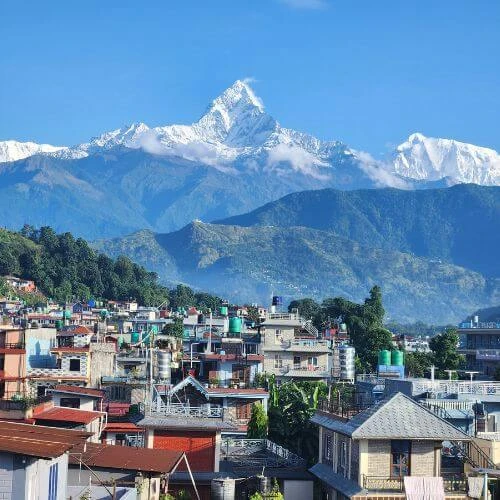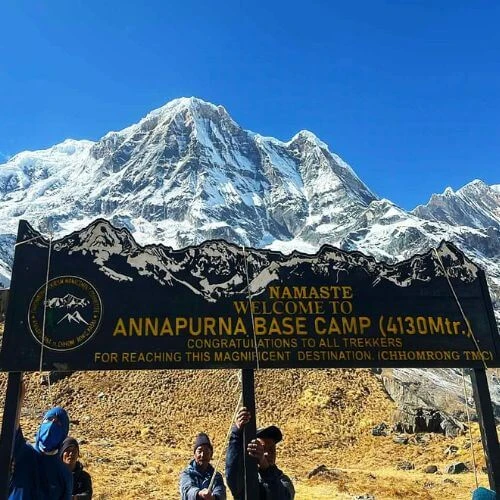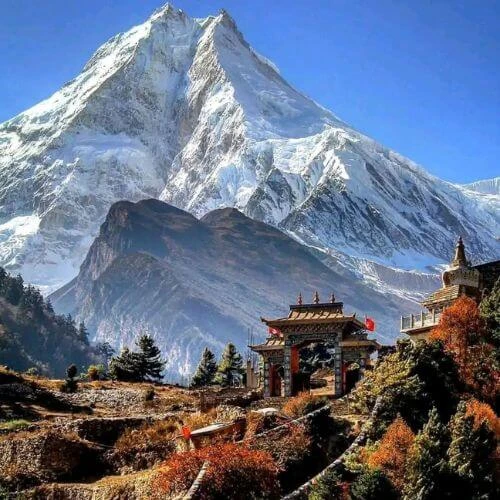Tsum Valley Trek
Tsum Valley is also known as the 'hidden valley', one of the most off-the-beaten treks in Nepal, offering a unique and relatively secluded trekking experience. Located in the northern part of Gorkha district, this trek is ideal for those seeking quiet trails and relief from busy trekking routes. Opened to trekkers only in 2008, it remains one of the most remote treks in Nepal, keeping its natural beauty and cultural traditions intact.
Part of the Manaslu Conservation Area and near the Tibetan border, this valley offers an opportunity to glance into a way of life that has remained untouched over several hundred years. The region uses Tibetan Buddhist traditions, with old monasteries and prayer wheels, chortens, and stone walls with carvings en route. Mu Gompa and Rachen Gompa are two highlights, with monks living quiet spiritual lives.

It also offers a stunning view of peaks like Mt. Ganesh, and Mt. Manaslu, locally known as Kutang Himal; the eighth highest mountain in the world, Himchuli, and Boudha Himal. Despite its natural beauty, Tsum Valley is one of the less crowded treks in Nepal, which is ideal for those who seek to be with nature in tranquility.
At an altitude of 3,700 meters, or 12,099 feet above sea level, Mu Gompa is the highest point of this trek. Because of the relatively low altitude, the risks of altitude sickness are fewer as compared to other treks in Nepal. Tsum Valley combines beautiful mountain scenery, cultural experiences, and a quiet atmosphere, thus making it an excellent option for those seeking remote trekking destinations in Nepal.
Basic Itinerary for Tsum Valley Trek in Nepal
Day 1: Drive from Kathmandu to Machha Khola ( 930m)
Day 2: Trek to Jagat ( 1,340m)
Day3: Trek to Lokpa ( 2,440m)
Day 5: Trek to Chumling ( 2,386m)
Day6: Trek to Chekampar ( 3,032m)
Day 7: Trek to Nile ( 3,361m)
Day 8: Day hike to Mu Gompa ( 2,386 m)
Day 9: Trek back to Chumling ( 2,386 m)
Day 10: Trek to Philim ( 1,570m)
Day 11: Trek to Machha Khola ( 930m)
Day 12: Drive back to Kathmandu
Manaslu Circuit Trek
The Manaslu Circuit Trek is an amazing adventure that takes trekkers around Mount Manaslu, the world's eighth-highest mountain at 8,163 meters or 26,781 feet. This trek is for those who want a quiet and unique experience on less explored trails in Nepal. This trekking route offers stunning views of mountains and landscapes, and diverse culture, and is one of the best off-beaten treks in Nepal.
On a clear day, trekkers have breathtaking views of Mt. Manaslu and other tall mountains like Himlung Himal, Cheo Himal, Kang Guru, and Annapurna II. A highlight of the trek is crossing the Larkya La Pass at 5,160 meters (16,930 feet) for a great view of the surrounding mountains and valleys.
The trek begins through lush lowland areas, with terraced fields, green forests, and flowing rivers. Moving upward, the rocky trails change into glacial rivers and peaceful valleys. This variation in scenery makes the trek one of the most beautiful and lesser-known trekking trails in Nepal.

The villages, like Samagaon and Samdo along the trekking trail, are home to indigenous communities of Gurung and Tibetan inhabitants. The villages give views of ancient traditions and Buddhist culture; monasteries, prayer wheels, and colored prayer flags add to the culture.
The trek also passes through the Manaslu Conservation Area, a home for various wildlife such as Himalayan tahr, blue sheep, and pheasants. This combination of natural beauty with the richness of culture makes it one of the first recommendations for those seeking less-visited trekking destinations in Nepal.
Basic Itinerary For Manaslu Circuit Trek
Day 1: Drive from Kathmandu to Machha Khola ( 930m)
Day 2: Trek to Jagat( 1,340m)
Day 3: Trek to Dyang (1,800 m)
Day 4: Trek to Namrung ( 2,660 m)
Day 5: Trek to Shyala ( 3, 500 m)
Day 6: Day hike to Pungyen Gompa and Trek to Samagaun ( 3,585m)
Day 7: Hike to Manaslu Base Camp (4,800 m)
Day 8: Trek to Samdo from Samagaun (3,860m)
Day 9: Cross Larkye La pass ( 5106m) and trek back to Bimthang ( 3790 m)
Day 10:Trek from Bhimthang Tilje Village (2300m) and drive back to Besisahar
Day 11: Drive back to Pokhara or Kathmandu
Nar Phu Valley Trek
The Nar Phu Valley Trek takes one to the most remote and untouched areas in Nepal. Situated in the northern area of the Annapurna, the trek is perfect for trekkers who like quiet trails and other sides of the Himalayas. This is one of the less-known trekking trails in Nepal and offers stunning landscapes and fascinating cultural experiences.
These villages, Nar and Phu, are small, and peaceful with the domination of Tibetan culture in each custom. You can spot the traditional stone houses of trekkers, which, combined with the colorful prayer flags and centuries-old monasteries such as Tashi Lhakhang, hold very deep spiritual significance among the inhabitants.

The landscapes here are much different from other routes, including narrow gorges, arid desert-like landscapes, and high plateaus framed by massive cliffs. Other highlights of this trek are great views of the Himalayan peaks such as Annapurna II, Kang Guru, and Pisang Peak.
One of the highlights of the trek is the crossing of the Kang La Pass, which is 5,320 meters (17,454 feet) high. The ascent itself is quite demanding; from the top, one will get unforgettable views of both the Annapurna and Dhaulagiri ranges.
The Nar-Phu Valley Trek is a quiet and peaceful route, far away from other busier trekking trails. This makes it one of the best off-beaten treks in Nepal, ideal for anyone looking for a less crowded, adventurous experience.
Basic Itinerary for Nar-Phu Valley Trek
Day 1: Drive from Kathmandu to Besisahar Lamjung ( 760 m)
Day 2: Drive to Dharapani/Koto ( 2,620m)
Day 3: Trek to Meta ( 3,560 m)
Day 4: Trek to Phu Gaun ( 4,085 m)
Day 5: Acclimatization Day in Phu Gaun
Day 6: Trek to Nar Phedi ( 3,545 m)
Day 7: Trek to Nar Gaun ( 4215 m)
Day 8: Trek to Ngawal Valley via Kangla Pass ( 5,320 m)
Day 9: Trek to Manang Village ( 3,519 m)
Day 10: Drive back to Besisahar (760 m)
Day 11: Drive back to Kathmandu
Everest Base Camp Trek via Gokyo Lake
The Everest Base Camp Trek via Gokyo Lakes is considered one of the longest treks in Nepal. This route combines the well-known Everest Base Camp trek with the stunning Gokyo Lakes, adding both adventure and peaceful scenery for the trekkers. Therefore, it is the most suitable option for anyone hoping to avoid the crowds in Everest Region.
The trek takes you to Gokyo Lakes, which are famous for their turquoise-colored waters and are some of the highest freshwater lakes in the world. At 5,357 meters, Gokyo Ri offers unparalleled views of Mount Everest, Lhotse, Cho Oyu, and Makalu. These views are the main highlights of this hike.

It further leads to Everest Base Camp, the dream destination for trekkers. Kala Patthar offers an excellent view of Mt. Everest and the nearby peaks at 5,545 meters in elevation, like Nuptse and Pumori.
The most thrilling part of the trek involves crossing Cho La Pass, which stands at 5,420 meters. A combination of Gokyo Lakes and Cho La Pass makes this trek one of the less-known hiking trails in Nepal. It is a great option for trekkers who want to explore remote trekking destinations in Nepal.
Basic Itinerary for Everest Base Camp Trek Via Gokyo Lake
Day 1: Fly from Kathmandu to Lukla and trek to Phakding (2,650 m)
Day 2: Trek to Namche Bazaar ( 3,440 m)
Day 3: Acclimatization Day at Namche Bazaar
Day 4: Trek to Dole ( 4,200 m)
Day 5: Trek to Machhermo ( 4,470 m)
Day 6: Trek to Gokyo (4,790 m)
Day 7: Acclimatization Day at Gokyo and hike to Gokyo Ri ( 5,400 m)
Day 8: Trek to Thangnak ( 4,700 m)
Day 9: Trek to Dzongla (4,855 m) via Chola Pass ( 5,420 m)
Day 10: Trek to Lobuche (4910m)
Day 11: Trek to Everest base Camp (5364 m)and back to Gorekshep (5,185 m)
Day 12: Hike to Kalapatthar (5555 m) and trek back to Pheriche
Day 13: Trek to Namche Bazaar ( 3,440 m)
Day 14: Trek back to Lukla and Fly back to Kathmandu
Makalu Base Camp Trek
The Makalu Base Camp Trek is one of Nepal's most difficult and isolated treks in Nepal. It is located in Makalu Barun National Park and provides breathtaking views of Makalu, the world's fifth-highest mountain. This trek is ideal for those searching out quiet, off-the-beaten-path trails in Nepal.
The trek provides breathtaking views of Chamlang, Makalu, Kanchenjunga, and other high peaks. In particular, the view of Makalu from Base Camp is awesome. On the route, trekkers get to experience the rich culture of the local people. The trekking route passes through small villages of Sherpas, Rai, and other ethnic groups; the trekkers get to see their traditional way of life.

The trek ends at Makalu Base Camp, situated at 5,050 meters. Base Camp is typically surrounded by a dramatic landscape, glaciers, and alpine valleys that enhance its beauty. The Makalu Base Camp Trek is one of Nepal's lesser-known trails, making it an ideal choice for those seeking a quieter, more remote adventure.
Basic Itinerary for Makalu Base Camp Trek
Day 1: Fly to Tumlingtar from Kathmandu and drive to Sedhuwa (1,700 m )
Day 2: Trek to Tashigaon (2,063 m)
Day 3: Trek to Kauma (2,500 m)
Day 4: Trek to Mumbuk (3,500 m)
Day 5: Trek to Nehe Kharka (3,660 m)
Day 6: Trek to Shershon (4,720 m)
Day 7: Trek to Makalu Base Camp (4,853 m)
Day 8: Explore Makalu Base Camp
Day 9: Trek from Makalu Base camp to Shipton-La Camp or Dobate (4,216 m)
Day 10: Trek from Shipton-La Camp/ Dobate to Sedhuwa (1,700 m)
Day 11: Trek back to Mure (1,980 m)
Day 12: Trek back to Tumlintar by Local Jeep (1,700 m)
Day 13: Fly back from Tumlingtar to Kathmandu
Khayer Lake and Khopra Ridge Trek
Khayer Lake and Khopra Ridge Trek are among the least-known trails in the Annapurna region of Nepal. This trek is not as famous as the routes to Annapurna Base Camp or the Poon Hill trek; thus, this route receives fewer visitors, which adds a touch of peaceful serenity. Khopra Ridge is one of the major highlights of this trek and offers spectacular views of Himalayan peaks like Dhaulagiri, Nilgiri, Bhara Shikhar, Annapurna I, and Machhapuchhre, along with many other peaks.
This is the best trek for those who have very little time, as it can be covered in a very short time. Another major highlight of the trek is Khayer Lake, which is a holy place for Hindus and is located at an altitude of 4,500 meters. The rocky landscapes surrounding the lake offer breathtaking views of the Himalayan peaks. During certain months of the year, it becomes a place where many pilgrims come together for holy rituals, adding a rich cultural perspective to the beauty of nature.

The trek usually starts from Pokhara, the beautiful lake-side city, which is often the start of treks for the Annapurna region. Khopra Ridge, at about 3,640 meters, is one of the quieter viewpoints in the region, offering stunning panoramas and a peaceful atmosphere. This trek is perfect for those seeking an off-the-beaten-path adventure in Nepal.
Basic Itinerary for Khayer Lake and Khopra Ridge Trek
Day 1: Drive to Pokhara
Day 2: Drive to Kimche (1,640 m) & Trek to Tadapani (2,630 m)
Day 3: Trek from Tadapani to Bayeli (3,240 m)
Day 4: Hike to Muldhai Viewpoint (3,637 m) & Trek to Khopra Danda (3,660 m)
Day 5: Trek to Khayer Lake & Explore, Trek back to Khopra Danda
Day 6: Trek to Tatopani
Day 7: Drive back to Pokhara
Day 8: Drive back to Kathmandu
Rara Lake Trek
Rara Lake Trek is one of the most beautiful, off-the-beaten trails in Nepal that leads to Rara Lake, the biggest lake in Nepal. Renowned for its turquoise blue water, the peaceful surroundings of this lake reflect a different scene now and then, with color changes at every part of the day. It is dark blue and calm in the early morning, greenish-blue during the afternoon, and brown, purple, or crimson depending upon the weather.
At an altitude of 2,990 meters above sea level, Rara Lake is situated within Rara National Park smallest protected area in Nepal, covering only 106 square kilometers. The park is rich in biodiversity despite its size, as it houses rare animals like red pandas and Himalayan black bears, along with a variety of pine, spruce, and juniper forests.

The Murma Danda is the highest point of this trek, at 3,630 meters, and commands an excellent, all-round panorama of the lake and surrounding snowcapped peaks, including the Ruma Kand (3,731 meters) and Malika Kand (3,444 meters). These peaks offer breathtaking views of the lake to the south and the scenic Mugu-Kamali River valley to the north.
With its serenity, diverse wildlife, and cultural importance, the Rara Lake Trek is an ideal journey for those looking for solitude and unspoiled natural beauty in Nepal.
Basic Itinerary for Rara Lake Trek
Day 1: Fly from Kathmandu to Nepaljung
Day 2: Fly from Nepalgunj to Jumla
Day 3: Trek to Chere Chaur
Day 4: Trek to Khali Langa
Day 5: Trek to Rara Lake
Day 6: Explore Rara Lake
Day 7: Trek back to Khali Laga
Day 8: Trek to Chere Chaur
Day 9: Trek to Jumla
Day 10: Fly to Nepaljung
Day 11: Fly back to Kathmandu
Upper Dolpo Trek
The Upper Dolpo Trek is one of the most remote, as well as one of the underestimated, trekking trails in Nepal; it offers a very unique adventure through remote and tranquil landscapes. Situated in northwest Nepal, this off-the-beaten trek remained closed to visitors until the early 1990s and showcases stunning views, Tibetan Buddhist culture, and a way of life untouched by time.
The trek goes through the high-altitude desert of Shey-Phoksundo National Park, the largest national park in Nepal, with a wide range of ecosystems, from alpine forests to rugged mountain terrain. A highlight is Phoksundo Lake, a sacred turquoise lake surrounded by stark mountains and rich in Bon cultural heritage.

This challenging yet rewarding trek takes 20-25 days, covers 200-250 kilometers, and crosses high passes such as the Kang La Pass at 5,360 meters. The trekkers will have a chance to see the rare wildlife, including snow leopards and Himalayan blue sheep while navigating across ever-changing landscapes.
The trail also follows the routes of ancient salt traders into Tibet, plied for centuries by yak caravans. This is a fantastic destination for photographers and those who seek adventure as Upper Dolpo offers stunning landscapes, rich culture, and isolation.
Basic Itinerary for Upper Dolpo Trek
Day 1: Fly to Nepalgunj from Kathmandu
Day 2: Arrival at Juphal and trek to Dunai
Day 3: Trek to Laina Odar
Day 4: Trek to Nawarpani
Day 5: Trek to Langa Camp
Day 6: Trek to Dho Tarap
Day 7: Rest day at Dho Trap
Day 8: Trek to Chhoila Khola Camp
Day 9: Chhoila Bhanjyang (Pass) to Sulung Khola Camp
Day 10: Trek to Tinjegaon
Day 11: Trek to Shimengaon
Day 12: Trek to Nisalgaon
Day 13: Rest day at Nisalgaon
Day 14: Trek to Saldang
Day 15: Trek to Namgung
Day 16: Trek to Sheygaon via Sela Pass
Day 17: Rest day at Sheygaon
Day 18: Trek to Phoksundo River Camp
Day 19: River Camp I to River Camp II
Day 20: River Camp II to Ringmo Village
Day 21: Rest day at Ringmo Village
Day 22: Ringmo to Chhepka
Day 23: Chhepka to Juphal
Day 24: Flight back to Nepalgunj
Dhorpatan Trek
The Dhorpatan Trek is one of the best-isolated treks in Nepal, offering something different in the Himalayas relating to natural beauty, rich biodiversity, and cultural diversity. It is located in the Myagdi and Baglung districts of Nepal home to the Dhorpatan Hunting Reserve, the only hunting reserve in Nepal, that includes a conservation area.
This less-crowded Nepalese trail was demarcated in 1987, covering an area of 1,325 square kilometers with elevations ranging from 2,850 to 5,500 meters. It contains a variety of landscapes-from subtropical forests to alpine meadows-that provide a home for a wide range of flora and fauna. Trekkers may see blue sheep, Himalayan tahr, snow leopards, and many bird species.

The trek starts from Beni, a town in the Myagdi district, and goes through traditional villages, dense forests, and alpine grasslands. Compared to Nepal's busy trails, it offers a peaceful and secluded experience. Trekkers will encounter Magar, Gurung, and Tibetan-influenced communities, learning about their unique cultures and lifestyles.
The trek takes 7–12 days depending on the route and pace. Accommodation is basic, in tea houses or local homestays, affording ample opportunity to interact with warm and friendly locals.
One of Nepal's lesser-known trekking trails, the Dhorpatan Trek is ideal for those seeking quiet, personal, and authentic experiences. It combines stunning nature, wildlife, cultural insights, and physical challenges into an unforgettable journey.
Basic Itinerary for Dhorpatan Trek
Day 1: Drive from Pokhara to Darbang via Beni (899 m)
Day 2: Trek to Dharapani (1,859 m)
Day 3: Trek to Lamsung (2,160 m)
Day 4: Trek to Jaljala (3,430 m)
Day 5: Trek to Dhorpatan (2,860 m )
Day 6: Explore Dhorpatan; Trek to Phagun Phedi (3,850 m)
Day 7: Hike to Phagun Danda
Day 8: Trek to Gurjaghat (3,104 m)
Day 9: Trek to Patichaur (2,097 m)
Day 10: Trek to Darbang (1,150 m)
Day 11: Drive back to Pokhara
Kanchenjunga Base Camp Trek
The Kanchenjunga Base Camp Trek is one of Nepal's less-known trekking trails that takes adventurers right to the base of the world's third-highest mountain, Kanchenjunga, standing at 8,586 meters. Due to its remote location in the eastern side of Nepal and tough physical challenges, this is one of Nepal's less visited trekking destinations.
Situated in eastern Nepal, this trek crosses the Kanchenjunga Conservation Area, covering 2,035 square kilometers. From subtropical forests to high-altitude glaciers, the variety of ecosystems supports a wide range of species, including the snow leopard, red panda, and Himalayan black bear.

This trek generally follows two routes, one to the north base camp and one to the south, and can be completed in 20-25 days over 230-270 kilometers. It starts with a flight to Taplejung, then proceeds through pretty remote villages, with dense forests, and mountain terrain. Being one of the unexplored trekking routes in Nepal, it is physically demanding with high passes and altitudes that range from 1,200 to 5,140 meters. The most challenging parts are crossing the Mirgin La Pass at 4,663 meters and reaching the base camps at around 5,140 meters.
For those looking for off-the-beaten trails in Nepal Kanchenjunga Base Camp Trek offers an extraordinary journey that guarantees one really unique and unforgettable adventure to a most remote region of Nepal.
Basic Itinerary for Kanchenjunga Base Camp Trek
Day 1: Fly to Bhadrapur from Kathmandu and Drive to Phidim (1,400 m)
Day 2: Drive to Taplejung (1,840 m)
Day 3: Trek to Chirwa (1,270 m)
Day 4: Trek to Amjlosa (2,500 m)
Day 5: Trek to Gyabla (2,730 m)
Day 6: Trek to Ghunsa (3,430 m)
Day 7: Acclimatization day at Ghunsa
Day 8: Trek to Kambachen (4,100 m)
Day 9: Trek to Lhonak (4,780 m)
Day 10: Hike to Pangpema (5,140 m)
Day 11: Trek back to Ghunsa (3,430 m)
Day 12: Trek to Sele le (4,290 m)
Day 13: Trek Sele la, Sinion La Pass, Mirgin La Pass, Sinelapcha La Pass and Tseram (4,850 m)
Day 14: Hike to Oktang Base Camp (5,364 )
Day 15: Trek to Torangden (2,995)
Day 16: Trek to Yamphudin (2,080 m)
Dy 18: Trek Down to Khebang (1,910 m )
Day 19: Trek to Khandembe (1,420 m)
Day 20: Trek to Tharpu (1,600 m)
Day 21: Drive to Bhadrapur by Bus (300 m)
Day 22: Drive back to Kathmandu
Conclusion
Besides the famous treks of Everest and Annapurna, Nepal still encompasses many lesser-known routes into the mountains. These routes pass through remote mountain landscapes and deep-rooted cultural traditions to show the beauty of the Himalayas in all quietness.
Hikes like the Hidden Tsum Valley and challenging Upper Dolpo Trek are much more than just a hike in making lifetime experiences. These routes connect travelers with unspoiled nature and centuries of tradition. Though trekkers need a little more preparation, physical fitness, and planning than other popular trails, they reward adventurers with breathtaking views, authentic cultural experiences, and unforgettable memories.
These Nepalese off-the-beaten treks open a door toward those aspects of the Himalayas that are rarely viewed by tourists. Each of the treks tells its story of breathtaking landscapes, cultural richness, and feats of human strength that turn these journeys into one of discovery.

Frequently Asked Questions
Why should I choose an off-the-beaten-path trek in Nepal?
Choosing an off-the-beaten-path trek in Nepal allows you to experience the untouched natural beauty, unique culture, and fewer crowds in Nepal that are hard to find in the popular trekking routes like Annapurna and Everest region.
What permits are required for remote treks in Nepal?
Most remote treks in Nepal fall under the protected area so trekkers need several permits including a TIMS card, trekking permits such as ACAP and MCAP as well as restricted area permits depending on which region you are traveling.
Are off-the-beaten-path treks in Nepal suitable for beginners?
Some off-the-beaten treks in Nepal are challenging due to rugged terrain, remote locations, and high altitude. It is always wise to conduct proper research before trekking on off-the-beaten paths in Nepal.
How difficult are the remote treks in Nepal?
Remote treks in Nepal can be tough, requiring good fitness and preparation. If you are planning to trek to less explored treks in Nepal be prepared for challenging terrain, basic facilities, and potential altitude challenges.



 based on 15 reviews
based on 15 reviews












